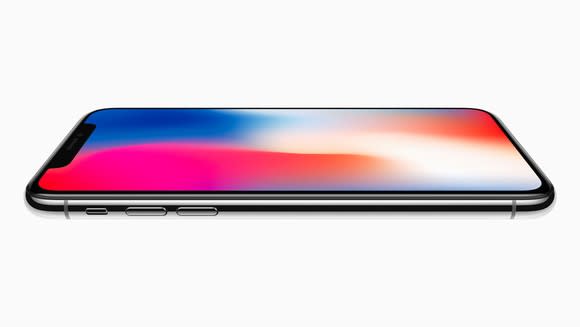Why Apple Inc.'s iPhone X Doesn't Have Better Battery Life
Early tear-down reports show that Apple's (NASDAQ: AAPL) new iPhone X -- the highest-end smartphone of the three phones the company announced back in September -- has a larger battery than even the iPhone 8 Plus does.
This is an impressive technical achievement, because the iPhone X fits in a physical footprint that's like that of the much smaller iPhone 8. What's interesting, though, is that, according to Apple's own marketing materials, the iPhone 8 Plus offers better battery life than the iPhone X does.

Image source: Apple.
Let's consider why that might be.
More pixels, more power
In a smartphone, the display is easily the biggest consumer of power. The display used in the iPhone X has a resolution of 2,436 by 1,125 pixels, which means it has about 32% more pixels than the 1,920-by-1,080 display found on the iPhone 8 Plus.
Those additional pixels mean greater power use. Not only does the increase in power consumption come from the display itself -- more pixels to drive should mean more power use -- but the higher resolution means the iPhone X must work harder to properly drive that higher-resolution display. That means more work for the display engine and graphics processor embedded inside the A11 Bionic chip.
Having the processor work harder means power consumption will go up, negatively affecting battery life.
The content matters
With liquid crystal display technology, which is used in both the iPhone 8 and 8 Plus, the power consumption of the display doesn't depend on the type of content being shown. With organic light emitting diode (OLED) display technology, which is what the iPhone X uses, that's not the case.
That's because with an OLED display, each pixel emits its own light. The power consumption of an OLED display will be quite low if much of the content is dark, since many of the pixels will be turned off, but it will be much higher if white dominates the image, since white requires that red, green, and blue sub-pixels all be lit up in equal proportion.
Apple's iOS user interface is chock-full of bright colors, especially white. If you have an iPhone, open up apps like Apple Music, Mail, and Messages, and you'll see that these apps are dominated by white.
Since Apple didn't rework the user interface of the iPhone X to focus more on darker colors, the display on the iPhone X is going to often be forced to draw power-hungry content, increasing power draw and reducing battery life.
The right move
Apple could've decided that, for marketing purposes, it would go with a darker-themed user interface to boost the amount of battery life it advertises, which could potentially increase sales.
As an alternative, Apple could've gone with a darker user interface and cut back on the battery size to cut component costs. Doing so could've allowed Apple to either sell the iPhone X for cheaper, potentially boosting unit demand, or to pocket greater profit margins per unit sold.
I think Apple made the right choice to not try to change the user experience it wanted just to squeeze out extra battery life. The hardware in a smartphone should be there to enable the user experience that the company building the device wants to deliver -- not the other way around.
More From The Motley Fool
6 Years Later, 6 Charts That Show How Far Apple, Inc. Has Come Since Steve Jobs' Passing
Why You're Smart to Buy Shopify Inc. (US) -- Despite Citron's Report
Ashraf Eassa has no position in any of the stocks mentioned. The Motley Fool owns shares of and recommends Apple. The Motley Fool has the following options: long January 2020 $150 calls on Apple and short January 2020 $155 calls on Apple. The Motley Fool has a disclosure policy.
